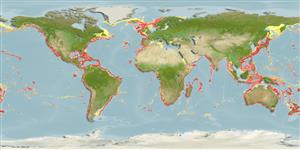лучеперые рыбы >
Beryciformes (Sawbellies) >
Berycidae (Alfonsinos)
Etymology: Beryx: Greek, beryx or berys = a name of a fish. Cuvier & Valenciennes (1829:221) precise that the name was used by Gesner from Varinus, but with no indication whatsoever helping identifying any species. After D'Arcy Wentworth Thompson (A glossary of Greek fishes, 1947), the name actually seems to come originally from Hesychius, but perhaps the name was not originally a fish name. Thompson compares it to meryx (ruminant), applied on skaros (Scarus), so it may have been applied on a parrot fish referring to its browsing/grazing behavior described by Aristoteles and followers.. More on author: Cuvier.
окружающая среда / климат / Range
экология
; морской батидемерсальный; пределы глубины 110 - 1000 m (Ref. 58302), usually 200 - 400 m (Ref. 35388). Deep-water, preferred 24°C (Ref. 107945); 70°N - 48°S, 180°W - 180°E
Worldwide in temperate and tropical latitudes, except the eastern Pacific. Eastern Atlantic: Greenland, Iceland, and Norway to Western Sahara and South Africa, including western Mediterranean. Western Atlantic: south to Brazil. Also found in Argentine (Ref. 2806). Indo-Pacific: East Africa (including the Madascar Ridge and Saya de Malha Bank, Ref. 33390) to Japan, Australia, and New Zealand (Ref. 5755). The limited number of records in the western Pacific is doubtless the result of limited fishing effort below 200 m (Ref. 9833).
Size / Вес / Возраст
Maturity: Lm ? range ? - ? cm
Max length : 100.0 cm TL самец/пол неопределен; (Ref. 26340); common length : 35.0 cm TL самец/пол неопределен; (Ref. 9833); наибольший вес (опубликованные данные): 2.5 kg (Ref. 9833)
колючие лучи спинного плавника (общее число): 4; членистые (мягкие) лучи спинного плавника (общее число): 18-20; колючие лучи анального плавника 4; членистые (мягкие) лучи анального плавника: 25 - 30. Body deep, compressed and has a large eye. Top of head, iris, back and all fins bright blood red. Orbital bones, cheeks and opercular bones shiny white. Breast shiny yellowish white. Body silvery with thin lengthwise lines (Ref. 37108).
Found in ca. 500 m on mud or sandy mud bottom (Ref. 11230). Occurs on the continental slope; adults demersal, young pelagic (Ref. 9563). Feeds on crustaceans, small fishes and cephalopods (Ref. 3321). A 35 cm SL specimen was found in the stomach of Latimeria (Ref. 58472). Young have heavy spines on the head (Ref. 35388).
Life cycle and mating behavior
половая зрелость | размножение | нерест | икра | Fecundity | личинки
Maul, G.E., 1990. Berycidae. p. 626. In J.C. Quero, J.C. Hureau, C. Karrer, A. Post and L. Saldanha (eds.) Check-list of the fishes of the eastern tropical Atlantic (CLOFETA). JNICT, Lisbon; SEI, Paris; and UNESCO, Paris. Vol. 2. (Ref. 7413)
Статус Красного Списка МСОП (Ref. 115185)
CITES (Ref. 94142)
Not Evaluated
Угроза для людей
Harmless
Использование человеком
рыболовство: коммерческий
дополнительная информация
ссылкиаквакультура (рыбоводство)особенности рыбоводствастепень растяжениягенетикачастоты аллелейнаследуемостьболезниобработкаMass conversion
инструменты
Специальные отчеты
Скачать в формате XML
ресурсы в Интернет
Estimates of some properties based on models
Phylogenetic diversity index (Ref.
82805): PD
50 = 0.6260 [Uniqueness, from 0.5 = low to 2.0 = high].
Bayesian length-weight: a=0.01445 (0.00876 - 0.02385), b=3.08 (2.93 - 3.23), in cm Total Length, based on LWR estimates for this species & (Sub)family-body (Ref.
93245).
Trophic Level (Ref.
69278): 4.1 ±0.76 se; Based on food items.
устойчивость к внешним воздействиям (Ref.
69278): низкий, минимальное время удвоения популяции 4.5-14 лет (K = 0.11-0.16; tmax >11).
Уязвимость (Ref.
59153): High to very high vulnerability (72 of 100) .
